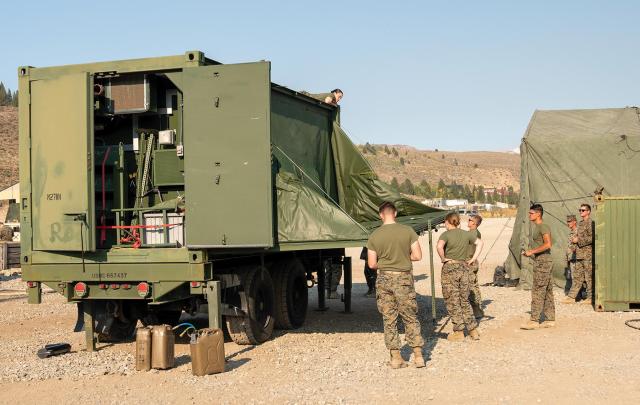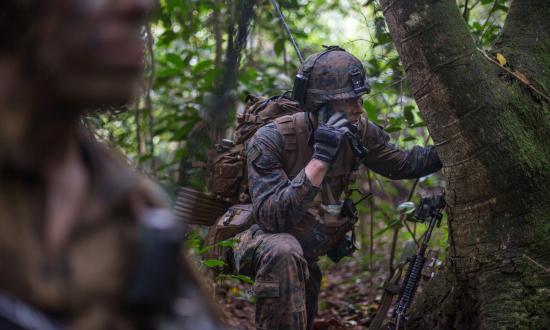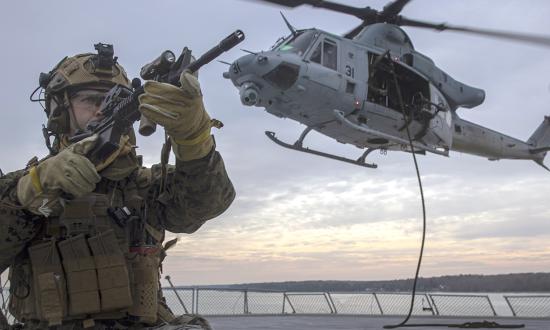Force Design 2030 has provided direction to better compete with the People’s Republic of China in the Indo-Pacific. Specifically, the April 2021 update to Force Design 2030 stated that the “stand-in force must remain resilient, under demanding conditions. When other elements of the Joint force are outside the weapons engagement zone (WEZ), preparing for deliberate surge layer missions, our forward elements will maneuver in the littorals to disrupt adversary operations.”1 This has permanently shifted logistical priorities in both training and procurement from the counterinsurgency fights of the past few decades to a wide range of new tools and training to meet the vast distances of the Indo-Pacific. Among the many new capabilities, forward provisioning (or scavenging) will be one of the initiatives needed to augment what will be a stressed logistics system.
Over the past two decades of conflict, food service has been absent from the front lines in a sustaining effort. Most food served in chow halls across Operation Iraqi Freedom and Operation Enduring Freedom was contracted. Food service specialists were relegated to contract “oversight” and scooping “heat and serves” in the rare periods in which a contracted entity could not reach a forward operating base.
Forward Provisioning
In an April 2022 Proceedings article, Marine Corps General Eric Smith outlined the challenges within the Indo-Pacific, stating:
The Biden administration’s Interim National Security Strategic Guidance designates the People’s Republic of China as the primary long-term threat to the nation’s interests and security, calling it “the only competitor potentially capable of combining its economic, diplomatic, military, and technological power to mount a sustained challenge to a stable and open international system.”2
The Marine Corps’ best strategy to counter China’s growing efforts is through the use of stand-in forces, best described as:
Units that are task-organized, trained, and equipped to disrupt an adversary’s plans at every point on the competition continuum. They are strategically placed where they can collect targeting data, strike to close choke points, or herd adversaries into areas where U.S. naval and joint forces can bring more weapons to bear.3
Forward provisioning (or foraging)—the ability of a military force to obtain sustainment within its zone of operations—has always been a part of warfare. There are multiple examples of when it has worked and when it has not. Forward provisioning at the small-unit (platoon and company) level provides the ground force commander the ability to reduce a unit’s signature and preserve the logistics supply chain for the most critical support. Without forward provisioning, units will have to rely on the Class I provisions (defined as food and drinking water) from stores that risk informing an ever-observant enemy of the strength, composition, disposition, and ultimately location of friendly forces. It is vital to give a maneuver commander the option to locally source from approved, resource-rich grocery stores, markets, and retail farms in the Indo-Pacific the kind of sustenance that will keep forces fed
and watered.
Forward provisioning is already underway throughout the logistics enterprise. For example, the newly added military occupational specialty (MOS) 1392 teaches bulk fuel specialists to additize, filter, and inspect locally procured aviation fuel to meet U.S. military standards. Similarly, bulk water specialists are trained to filter and inspect water from rivers and oceans for consumption on the battlefield. The logistics enterprise has coalesced around bulk-fuel and bulk-water provisioning, and it is time to bring food service into the 21st-century forward-provisioning efforts. Years of counterinsurgency have lulled the food-service community into believing a new unitized group ration or meal ready to eat is the answer, akin to changing the paint scheme on the M1A1 Abrams tank. These efforts are helpful, but as with the other MOS communities, there are additional options in the event the supply chain is disrupted.
Some solutions include:
1. Food water risk assessments. Expand approval to conduct assessments to include food service and a greater number of medical professionals typically assigned at tactical units.
2. Contracting. Lower the threshold to purchase in the local economy to support forward provisioning when operating within the weapons engagement zone (WEZ).
3. Training. Increase butchery and field-cooking training for all food service personnel, especially at the entry level.
Signature Management
Near the end of the Vietnam War, food-service operations drifted away from the reusable mess kits that defined the World War II and Korean War food service experience. Today, field-mess sites contain disposable plastic plates, utensils, and cups, which accompany every unitized group ration. The military must return to mess kits, relinquishing dependence on single-use and throwaway items. The modern example is sealable, with utensils that will reduce the mountains of trash and help to reduce the signature of a formation. The relatively cheap mess kit allows commanders to support feeding as has been done since the beginning of armed conflict.
NATO allies already rely on mess kits, and the U.S. military is the only Western force tied to a supply system in this manner. Thermal blankets are needed to conceal heat radiation from cooking to reduce the heat signature of a mess site. A replacement is badly needed for the decrepit expeditionary field kitchens (EFKs), which bring numerous challenges including requirements for intense maintenance, a prime mover, and camouflage. A new EFK is needed; one that is light, mobile, and easy to move by air, land, or sea.
Bases in Iraq and Afghanistan were littered with burn pits needed to dispose the mountains of refuse generated by U.S. military forces. The future fight will have no room for such luxury, never mind the health hazards. Over the past few decades, food service was highlighted by gaps in defensive lines that used foreign contracted labor by the tens of thousands to cook, clean, and serve meals to U.S. forces. The current logistical supply chain will doom any cover and concealment efforts by maneuver forces if the U.S. military does not alter basic small-unit logistics support. I escorted, at great personal risk, truckloads of ice cream to bases in Iraq and often was reminded by leaders of how impressive a military force we were, so capable of a wide range of options so far from home. We must not and cannot make similar mistakes in the future.
Historical Lessons
A lack of skilled foraging capability has doomed U.S. forces in the past. During the 1941–42 siege of Corregidor in the Philippines, nearly 100,000 U.S. military personnel surrendered to Imperial Japanese Forces not from the lack of ammunition or the will to fight, but from the lack of training to locally access food and water. Army General Jonathan M. Wainwright alerted General Douglas MacArthur that “with deep regret,” troops on Bataan were “fast folding up,” and that the men were so weak from malnutrition “that they have no power of resistance.”4
Similarly, the situation became so dire during the 1941–42 British defense of Singapore that “There was only enough water supply for 24 hours due to breaks in the water mains and pipes. Furthermore, the main reservoirs were all in Japanese hands.”5 Compounding the water situation, “there was only three days’ worth of rations.”6 British Lieutenant General Arthur E. Percival would surrender the entire Allied garrison on 15 February 1942.
The recently released Tentative Manual for Expeditionary Advanced Base Operations states, “At the lowest level of employment, planners must consider operational contract support (OCS), which enables expeditionary units to develop a foraging skillset enabled by micropurchases.”7 The manual additionally states, “Incorporation of these alternatives to the traditional military supply system is a force multiplier in support of stand-in forces.”8
The Tentative Manual for Expeditionary Advanced Base Operations reaffirms the doctrinal support for forward provisioning, as it is critical to reducing costs and lowering risk to the distribution network. Reinforcing the message of Tentative Manual for Expeditionary Advanced Base Operations is the stark reality facing the supply chain within the Indo-Pacific. General Eric Smith best summed it up in a January 2022 Military Times article: “Why would I move water to the South China Sea?” he asked. “That’s insane, why would I move food?”9 The Food Service School at the Marine Detachment Fort Lee, Virginia, agrees.
Looking Forward
The Marine Corps has experimented with changes to the Food Service School, the Food Service Non-Commissioned Officer Courses, and the Staff Non-Commissioned Officer Course, and plans to do the same shortly with entry-level training for the newest food service Marines. While keeping existing training and readiness standards, this includes the cutting of meat and greater emphasis on cooking in the field environment (signature management, menu design specific to the Indo-Pacific, and novel cooking techniques). Concurrently, the Food Service School has experimented with using mess kits to replace the disposable and trash inducing single-use items commonly found at field mess sites throughout the Marine Corps.
In addition, the Food Service School, alongside the Marine Corps Warfighting Lab, has experimented with a new Expeditionary Field Feeding System at Fort Lee that will use a commercial off-the-shelf system that is lightweight, easily concealable, mobile, and reduces the signature of an expeditionary feeding site. The Food Service School taught six Marine Corps Basic Officer Courses with great success at The Basic School in Quantico, Virginia, to provide an orientation on foraging. By employing well-proven training techniques and commercially available technologies, food service of the future will be able to support operations within the WEZ.
The aim of forward provisioning is not to replace or diminish the existing supply system, but rather to augment it. Much like any good fire-support plan, food service must be layered, interconnected, and well-defined. Forward provisioning is no different and must be a component of an overall feeding plan to support expeditionary advanced base operations.
U.S. Marine Corps (Scott Jenkins)
1. Gen David H. Berger, USMC, Force Design 2030 Annual Update (Washington, DC: U.S. Marine Corps, April 2021).
2. Gen Eric Smith, USMC, “Stand-in Forces: Adapt or Perish,” U.S. Naval Institute Proceedings 148, no. 4 (April 2022).
3. Smith, “Stand-in Forces: Adapt or Perish.”
4. Louis Morton, The Fall of the Philippines, 50th anniversary commemorative edition (Alexandria, VA: St. John’s Press, 2016), 455.
5. Stephanie Ho, “Battle of Singapore,” Singapore Infopedia, 19 July 2013; and Stanley Tik Loong Tan, Battle for Singapore: Fall of the Impregnable Fortress (Singapore: National Archives of Singapore, 2011), 253.
6. Ho, “Battle of Singapore,” and Tan, Battle for Singapore, 253.
7. Secretary of the Navy, Tentative Manual for Expeditionary Advanced Base Operations (Washington, DC: Headquarters, U.S. Marine Corps, February 2021).
8. Secretary of the Navy, Tentative Manual.
9. Philip Athey, “Butchering Pigs, Foraging Water and Fuel—the Future of Marine Logistics,” Military Times, 27 January 2022.












